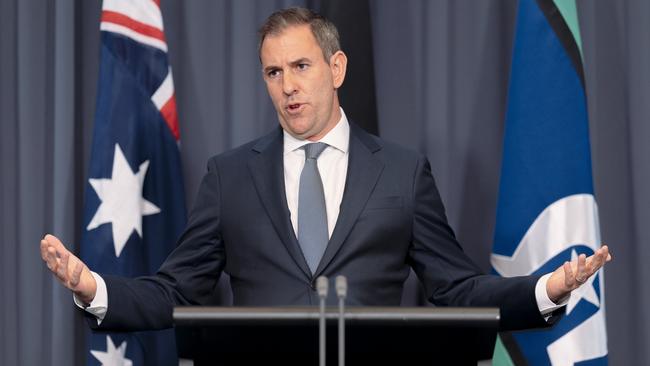Australia escapes per-capita recession as feeble economy turns a corner
Anthony Albanese will enter the federal campaign with an improved economic scorecard after Australia’s growth gathered momentum at the tail end of last year.

Anthony Albanese will enter the federal election campaign with an improved economic scorecard after Australia’s growth gathered momentum at the tail end of last year, narrowly exiting the nation’s unprecedented per-capita recession.
With the Prime Minister expected to call an election in days, the Australian Bureau of Statistics on Wednesday reported that Australia’s gross domestic product expanded by 0.6 per cent in the December quarter, the fastest pace in two years as households and governments engaged in a spending spree.
But the increase is likely to reduce further the chances of another Reserve Bank rate cut in April.
The GDP lift – in line with the average rate recorded in the decade preceding the pandemic – brought annual growth to 1.3 per cent, still one of the weakest results outside the pandemic since the early 1990s recession.
Jim Chalmers declared the economy had “turned a corner” after the figures were released, exuding confidence about the economic outlook in the year ahead. “What we’re seeing here is substantial momentum in the Australian economy,” the Treasurer said in Brisbane.
Dr Chalmers pointed to the increased contribution of the private sector, which had experienced recession-like conditions in recent quarters, providing no support to growth. “This is looking more and more like the soft landing that we’ve been planning for and preparing for,” he said.
The tepid GDP reading broadly aligns with the Reserve Bank’s expectations that the economy is starting to gain momentum after its aggressive run of inflation-taming rate hikes crimped growth and slowed activity to a crawl.
But with the data outstripping the central bank’s forecasts for annual GDP growth of 1.1 per cent, the figures are likely to reduce the odds that the RBA will deliver back-to-back rate cuts in April, leaving the next reduction until after the election.
Noruma senior economist Andrew Ticehurst agreed that the new GDP figures would make for “uncomfortable reading” for the central bank, dismissing the chance of another quarter-percentage-point rate cut on April 1. “A quarter-percentage-point cut in May – still our central case – is heavily reliant on a benign March quarter inflation reading,” he said.
After the economy recorded the longest decline in living standards on record – seven consecutive quarters in which GDP per capita declined – the ABS figures showed the first increase since 2022, albeit just 0.1 per cent, as population growth slowed. Despite that uptick, Challenger chief economist Jonathan Kearns said Australians were still $2400 worse off each year than they would have been under pre-pandemic trends.
Helping drive growth in the economy across the December quarter was a lift in real incomes, as Labor’s overhauled tax cuts and moderating inflationary pressures lifted household consumption, which contributed 0.3 percentage points to GDP growth. While essentials such as rent and health costs continued to be the strongest contributors to the rise in spending, discretionary purchases also climbed as consumers hit Black Friday sales and headed to music and sporting events.
Soaring government expenditure again made an outsized contribution to growth, rising to a record share of the economy – 27.7 per cent of GDP, well above its pre-pandemic trend of below 23 per cent.
The ABS attributed the increase in government expenditure, which added 0.2 percentage points to GDP, to a rise in recurrent spending and capital works, as federal and state governments ramped up outlays for public services including health, education, defence and the Pharmaceutical Benefits Scheme.
KPMG chief economist Brendan Rynne said the level of spending was unsustainable given tax settings, with the spree eroding the federal budget. “Managing the budget will be an important element of pivoting to sustainable growth driven by the private sector,” Dr Rynne said. “The improvement in today’s private-sector growth is a positive sign, but a sustained upswing is heavily dependent on productivity growth.”
On that measure, however, the data revealed Australia’s recent run of anaemic productivity outcomes continued through the December quarter, declining a further 0.1 per cent to languish around 2016 levels.
Combined with signs that the jobs market was beginning to tighten again and the risk that inflationary pressures could flare again, NAB senior economist Taylor Nugent warned that the further slide in productivity could delay rate cuts by the RBA.
“Productivity growth remains weak and unit labour cost measures remain elevated in today’s data, which support the RBA caution that disinflation could stall,” Mr Nugent said.
A jump in exports added 0.2 percentage point to GDP. The ABS attributed the increase to the removal of Indian trade tariffs, which spurred chickpeas sales, and a lift in intellectual property sales relating to pharmaceuticals and computer software. However, Donald Trump’s move to unveil a suite of tariffs risks derailing this resilience, economists warned.
“Trade war tensions also pose additional downside risks for the economy this year,” AMP economist My Bui said.




To join the conversation, please log in. Don't have an account? Register
Join the conversation, you are commenting as Logout